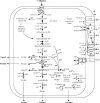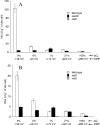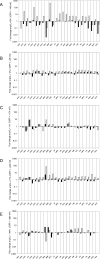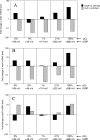Control of enterotoxin gene expression in Bacillus cereus F4430/73 involves the redox-sensitive ResDE signal transduction system
- PMID: 16952956
- PMCID: PMC1595479
- DOI: 10.1128/JB.00702-06
Control of enterotoxin gene expression in Bacillus cereus F4430/73 involves the redox-sensitive ResDE signal transduction system
Erratum in
- J Bacteriol. 2007 Mar;189(6):2581
Abstract
In contrast to Bacillus subtilis, the role of the two-component regulatory system ResDE has not yet been investigated in the facultative anaerobe Bacillus cereus. We examined the role of ResDE in the food-borne pathogen B. cereus F4430/73 by constructing resDE and resE mutants. Growth performances, glucose metabolism, and expression of hemolysin BL (Hbl) and nonhemolytic enterotoxin (Nhe) were analyzed in the three strains under distinct oxygenation and extracellular oxidoreduction potential (ORP) conditions. We show that growth and glucose metabolism were only moderately perturbed in both resDE and resE mutants under aerobiosis, microaerobiosis, and anaerobiosis generated under N(2) atmosphere (initial ORP = +45 mV). The major effects of resDE and resE mutations were observed under low-ORP anaerobic conditions generated under hydrogen atmosphere (iORP = -148 mV). These conditions normally favor enterotoxin production in the wild type. The resE mutation was more deleterious to the cells than the resDE mutation, causing growth limitation and strong deregulation of key catabolic genes. More importantly, the resE mutation abolished the production of enterotoxins under all of the conditions examined. The resDE mutation only decreased enterotoxin expression under anaerobiosis, with a more pronounced effect under low-ORP conditions. Thus, the ResDE system was found to exert major control on both fermentative growth and enterotoxin expression, and it is concluded that the ResDE system of B. cereus should be considered an anaerobic redox regulator. The data presented also provide evidence that the ResDE-dependent regulation of enterotoxins might function at least partially independently of the pleiotropic virulence gene regulator PlcR.
Figures





Similar articles
-
The redox regulator Fnr is required for fermentative growth and enterotoxin synthesis in Bacillus cereus F4430/73.J Bacteriol. 2007 Apr;189(7):2813-24. doi: 10.1128/JB.01701-06. Epub 2007 Jan 26. J Bacteriol. 2007. PMID: 17259311 Free PMC article.
-
Anaerobic cells of Bacillus cereus F4430/73 respond to low oxidoreduction potential by metabolic readjustments and activation of enterotoxin expression.Arch Microbiol. 2006 Apr;185(3):222-33. doi: 10.1007/s00203-006-0090-z. Epub 2006 Feb 10. Arch Microbiol. 2006. PMID: 16470372
-
Fnr mediates carbohydrate-dependent regulation of catabolic and enterotoxin genes in Bacillus cereus F4430/73.Res Microbiol. 2010 Jan-Feb;161(1):30-9. doi: 10.1016/j.resmic.2009.11.003. Epub 2009 Nov 26. Res Microbiol. 2010. PMID: 19944753
-
The Food Poisoning Toxins of Bacillus cereus.Toxins (Basel). 2021 Jan 28;13(2):98. doi: 10.3390/toxins13020098. Toxins (Basel). 2021. PMID: 33525722 Free PMC article. Review.
-
[Bacillus cereus enterotoxins].Zh Mikrobiol Epidemiol Immunobiol. 2007 Mar-Apr;(2):105-10. Zh Mikrobiol Epidemiol Immunobiol. 2007. PMID: 17523492 Review. Russian.
Cited by
-
Influence of anaerobiosis and low temperature on Bacillus cereus growth, metabolism, and membrane properties.Appl Environ Microbiol. 2012 Mar;78(6):1715-23. doi: 10.1128/AEM.06410-11. Epub 2012 Jan 13. Appl Environ Microbiol. 2012. PMID: 22247126 Free PMC article.
-
Identification of the main promoter directing cereulide biosynthesis in emetic Bacillus cereus and its application for real-time monitoring of ces gene expression in foods.Appl Environ Microbiol. 2010 Feb;76(4):1232-40. doi: 10.1128/AEM.02317-09. Epub 2009 Dec 28. Appl Environ Microbiol. 2010. PMID: 20038713 Free PMC article.
-
From cereus to anthrax and back again: Assessment of the temperature-dependent phenotypic switching in the "cross-over" strain Bacillus cereus G9241.Front Microbiol. 2023 Mar 2;14:1113562. doi: 10.3389/fmicb.2023.1113562. eCollection 2023. Front Microbiol. 2023. PMID: 36937299 Free PMC article.
-
From transcriptional landscapes to the identification of biomarkers for robustness.Microb Cell Fact. 2011 Aug 30;10 Suppl 1(Suppl 1):S9. doi: 10.1186/1475-2859-10-S1-S9. Epub 2011 Aug 30. Microb Cell Fact. 2011. PMID: 21995521 Free PMC article. Review.
-
ResDE-dependent regulation of enterotoxin gene expression in Bacillus cereus: evidence for multiple modes of binding for ResD and interaction with Fnr.J Bacteriol. 2009 Jul;191(13):4419-26. doi: 10.1128/JB.00321-09. Epub 2009 Apr 24. J Bacteriol. 2009. PMID: 19395489 Free PMC article.
References
-
- Agaisse, H., M. Gominet, O. A. Okstad, A. B. Kolsto, and D. Lereclus. 1999. PlcR is a pleiotropic regulator of extracellular virulence factor gene expression in Bacillus thuringiensis. Mol. Microbiol. 32:1043-1053. - PubMed
-
- Andersson, A., P. E. Granum, and U. Ronner. 1998. The adhesion of Bacillus cereus spores to epithelial cells might be an additional virulence mechanism. Int. J. Food Microbiol. 39:93-99. - PubMed
Publication types
MeSH terms
Substances
Associated data
- Actions
LinkOut - more resources
Full Text Sources
Other Literature Sources
Research Materials

